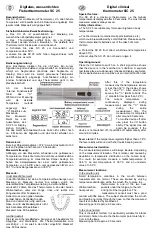
4/18
29.05.2002
CE1G2261xx
•
Sollten im Referenzraum thermostatische
Heizkörperventile installiert sein, müssen diese
vollständig geöffnet werden.
•
Die örtlichen Vorschriften für Elektroinstallationen sind
einzuhalten.
Commissioning
1. Mounting
Remove controller from its base by proceeding according
to Fig. A. For mounting, refer to Figs. B and C.
(also refer to “Mounting notes“).
2. Check wiring
For the electrical connections, refer to “Connection
diagram“ (also refer to Figs. D and E).
Note: do not use stranded wires, only solid wires or
stranded wires with ferrules.
3. Remove the battery transit tab
As soon as the battery transit tab is removed, the controller
starts to operate (also refer to Fig. F).
4. Configuration
4.1 Accessing the heating engineer level
The heating engineer level will be enabled by pressing
simultaneously the warmer and colder buttons and by
rolling the roller selector away from the display and then
toward the display (also refer to Fig. H).
4.2 Functions
4.2.1 Calibrating the temperature sensor
After activating the heating engineer level, the
CAL
symbol
will flash. When pressing the roller selector, the room
temperature currently measured flashes and can now be
recalibrated by a maximum of ± 2 °C by rolling either
toward the display or away from it. To store the re-
calibration, press the roller selector (also refer to Fig.
).
4.2.2 Setpoint limitation
There are 2 setting choices available:
or
On the heating engineer level, change from the flashing
CAL
symbol to the setpoint limitation symbol by rolling
toward the display.
Press to accept. 5...29 °C will flash (factory setting). Press
to accept or continue rolling.
Setting 16...29 °C will flash.
Press to accept (also refer to Fig.
).
4.2.3 Control mode
On the heating engineer level, change from the flashing
CAL
symbol to the symbols of the various control modes
by rolling away from the display (also refer to Fig.
).
Press to accept.
(factory setting) will flash. Press
to accept (Fig. 3) or continue rolling toward the display to
select one of the following control modes:
,
PID 6, PID 12 or
. Press to accept the
required control mode.
A brief description of the control modes is given below
(also refer to Fig.
).
Self-learning,
adaptive control:
Suited for all standard applications (factory
setting).
PID 12
Normal controlled systems:
For locations with normal temperature variations.
PID 6
Fast controlled systems:
For locations with significant temperature
variations.
Difficult controlled systems:
Proper 2-position controller with a switching
differential of 0.5 °C.
4.2.4 Frost protection mode
Use operating mode selector to select symbol
(also
refer to Fig.
).
If the standard value of 5 °C need to be changed, the frost
protection setpoint
must be changed via temperature
menu
T
(refer to the Operating Instructions).
5. Replacing the controller
Proceed according to Fig. G.
6. Functional check
a) Check the display. If there is no display, check the
correct fitting and function of the batteries.
b) Comfort mode
c) Select temperature menu
T
and adjust the temperature
setpoint
to 29 °C (refer to the Operating
Instructions)
d) The relay must be energized and thus the actuating
device activated within one minute. Flame symbol
will appear on the display. If that is not the case:
•
Check actuating device and wiring
•
The room temperature is possibly above 29 °C
e) Reset the setpoint temperature
to the initial value
(standard value 19 °C or individual setting)
f) Select the required operating mode
7. Reset
User-defined data:
Press the button behind the pin opening for at least one
second: this resets the user-specific settings to their
default values (the heating engineer settings will not be
changed). The clock starts at 12:00. During the reset time,
all sections of the display light up, enabling them to be
checked.
All user-defined data plus the heating engineer
settings:
Press the button behind the pin opening together with the
warmer and colder buttons for at least one second.
After this reset, the
factory settings
will be reloaded (also
refer to section “Factory settings“ in the operating
instructions).




































